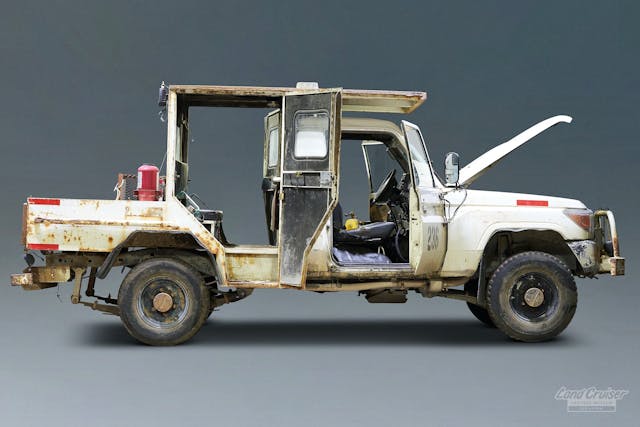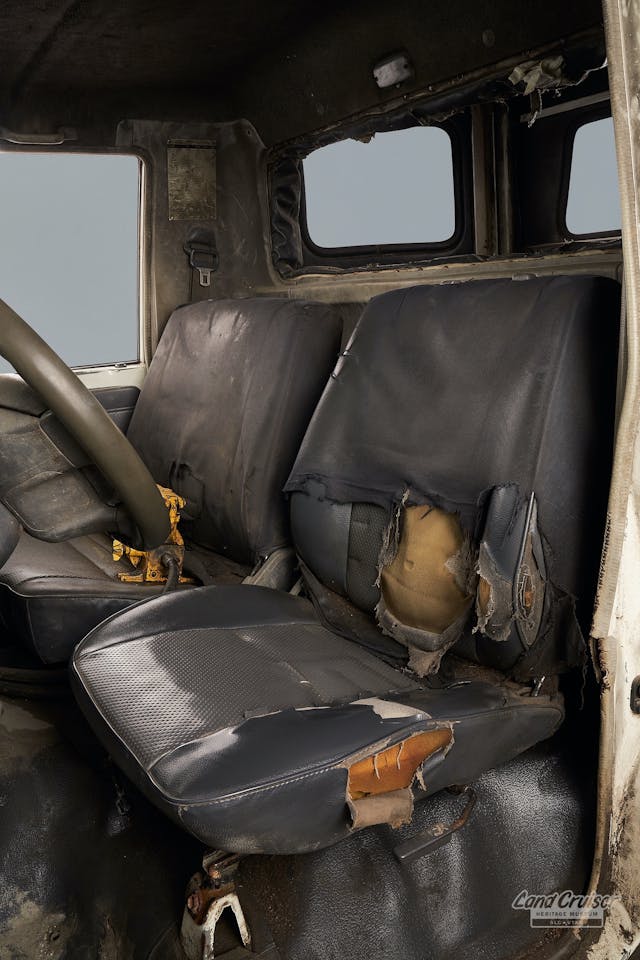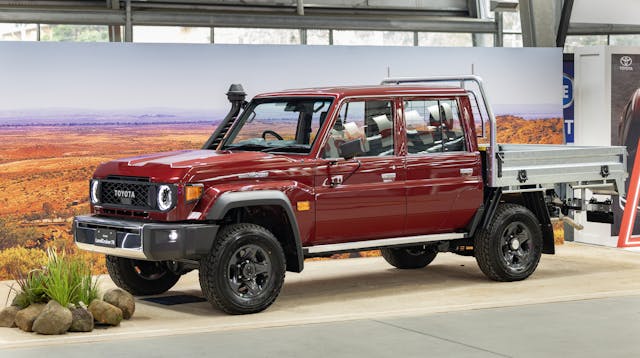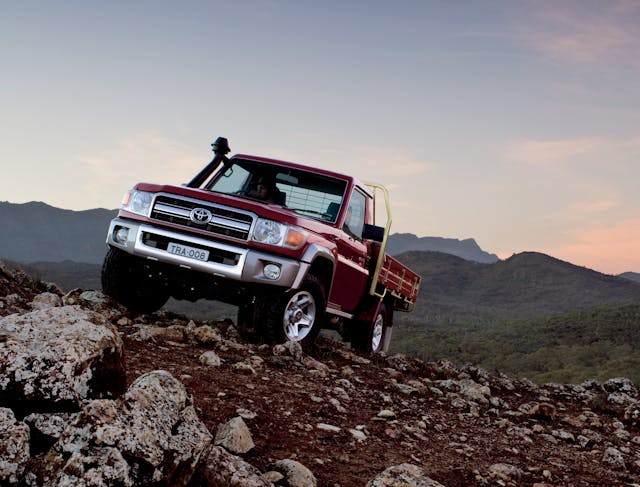The Underland Cruiser: Toyota’s 70-Series Land Cruiser Is a Mining Workhorse
With the launch of the new 2024 Land Cruiser, Toyota attempted to get back to the roots of its globally beloved offroader. The new Land Cruiser is set to be priced much lower than the previous generation, meaning you might actually see one out on the trails getting muddy. But quietly, Toyota also released a mildly updated version of the 70-Series Land Cruiser from the 1980s. Outside of Japan, it’s only sold to the public only at Australian Toyota dealerships, although you can actually buy one in North America. The one caveat: you have to own a mine.
Well, technically, so long as your 70-Series stays off public roads, you’re in the clear. But it’s at gold and copper mines, and nearly every type of resource extraction site across the globe, that you can spot Land Cruisers working alongside huge dump trucks and excavators. Land Cruisers crawl slowly through the darkness, or down into open pit mines. Some go into the inky black underworld brand new and don’t emerge again until they are bound for the boneyard. They are almost universally 70-Series models, Land Cruisers of the old school, simple in construction and as tough as the business end of a pickaxe.


“It’s an important example of commercial usage of the Land Cruiser,” says Dan Busey of the Land Cruiser Heritage Museum in Salt Lake City, Utah, “My understanding is that they’re the only things tough enough to survive the extremely harsh environment in a mine.”
A few years ago, the museum acquired a 2012 Land Cruiser modified by Miller Technology of North Bay, Ontario. Just over a decade old and with the equivalent of 36,000 miles on the odometer, it looks like it spent that decade on the surface of Mars. It’s rusty, battered, slightly bowed in the middle, and absolutely covered in the dust and dirt of a mine. But despite the tattered seats and bare bones interior, there’s something magnificent about it. This is no shiny Range Rover parked on Rodeo Drive. This is a working truck, tired after its last shift, but still tough as nails.

Miller Technology is just one of a handful of specialist mining equipment manufacturers that prepare Land Cruisers for the rough and tumble of mineral extraction. The Toyotas come directly from Japan, in a very basic cab and chassis form, and are heavily modified for their purpose. They can be set up with cranes or booms for mechanics working on huge mining equipment, are sometimes fitted with armor to protect the roof from falling rocks, can be built to carry as many as eight passengers to and from the rock face, or kitted out with a scissor lift.
Replacing the bumpers with heavy steel units is standard fare for an industry where stuff often ends up hitting other stuff. Perhaps a more technologically interesting upgrade is the sealed wet-clutch brakes, which are encased in housings that prevent dust and debris from scoring the rotors.
Depending on the application, Miller Tech can also swap out the diesel powertrain for a battery pack and electric drive. Standard equipment on these 70-series workhorses is the Toyota 1HZ, a 4.2L inline six that is good for about 130 hp and 210 lb-ft of torque, and has the working lifespan of Stonehenge. Swapping to electric allows for reduced emissions in confined spaces, but is very expensive, essentially doubling the cost. According to Miller Tech, the demand ebbs and flows depending on specific projects and available government grants.



Around the world, this generation of Land Cruiser and the contemporary Hilux pickup have cemented Toyota’s reputation for incredible durability and endurance offroad. Probably the best example is the Harb al-Tūtūya, or Great Toyota War of 1987, in which a bunch of irregular forces in Toyotas threw the well-equipped occupying Libyan forces out of Chad. You find Land Cruisers in the most desolate places in the world, from the sands of the world’s deserts to the emptiness of the Australian Outback.
Patrick Redmond is a geologist, and has worked in and around mining and mineral exploration around the world. He recounts buying a couple of Land Cruisers for cash in a market in Mongolia, the way all mining Toyotas in South America seem to be painted red for unknown reasons, and the first time he drove a long wheelbase one in Australia and nearly hit a kangaroo.
“In the Outback, a Land Cruiser is basically your lifeline,” he says.
But underground is even tougher. Copper mining, for instance, is an acidic process, and the equipment that works in a copper mine is under constant attack on a molecular-level. In this kind of environment, even a Land Cruiser might only last a few years before partially dissolving into scrap. There’s no sentimentality here: these Toyotas are bought, consumed, and then sent to the boneyard. It’s not legal to road-register them as they do not conform to regulations governing crash protection or emissions controls.
But that simplicity makes them tough. With roll-up windows and barely any electronics governing the diesel engine, this generation of Land Cruiser is exactly the kind of machine that gave its nameplate a global reputation. Land Rover owners know that their rigs are up for adventure—but you’d better bring your toolkit and wiring diagram along. A 70-Series Land Cruiser is like a shovel. You can break it, but you really have to work at it.

The life of a mining Land Cruiser is nasty, brutish, and short. The industry average is just five years of service. Looking at the Land Cruiser Heritage Museum’s example, you can see why they don’t last long, at least compared to civilian use. It’s just that nearly everything else mining operations has tried to use just fails under pressure even faster.

Back on the earth’s surface, between the perils of kangaroos and the ruggedness of pretty much any location outside of any city limits, it’s perhaps no surprise that Toyota still sells its 70-Series brand-new down under. An entry-level Land Cruiser workmate-grade starts from under seventy thousand dollary-doos, or just over $40,000 in U.S. currency.
For that kind of money, you have to think that Toyota would sell a few commercial-application Land Cruisers here, rather than buyers have to go through companies like Miller Tech. Sure, the Land Cruiser would have to get the same pass on governmental regulations that it does in Australia, but it’s at least theoretically possible.
On the plus side, the continued use of the 70-Series as a working truck does mean that Toyota still makes parts available. If you have a Land Cruiser of this vintage, you already know that it’s as tough as the axe of Gimli, son of Glóin. A strength forged in steel, capable of delving beneath the earth, only coming out again when the job is done.
***
Check out the Hagerty Media homepage so you don’t miss a single story, or better yet, bookmark it. To get our best stories delivered right to your inbox, subscribe to our newsletters.



Cool to see this article! I’m currently living in North Bay, ON, right near the aforementioned Miller company, and I’ve enjoyed looking at their yard stocked full of those LC70s that you just don’t see on Canadian roads (other than a handful of older, mostly imported, ones)!
It’s one of my favorite vehicles out there, so it’s pretty cool to have do many right in the neighborhood
I lived in Australia in the mid-to-late 60s and work for a company called these brothers. This was located in central Queensland a place called Mount Isa which was a giant copper mind along with all other types of minerals.
They had a lot of Toyotas. From cement trucks to Toyota Land Cruiser’s and also Toyota flatbeds.. These had the cab of a regular Toyota. All were four-wheel drives. This was my vehicle for work. Basically there was a lot of things that would remind you of the Jeep especially where like fuel tank was. The engine was nothing more than General Motors metric size 6 cylinder different carburetor and a fuel pump that you could work mechanically. These were very sought after vehicles. Certainly built a lot better than Land Rovers.
These were three speeds transmissions with the transfer case I can’t remember if there was a high low range anymore. These were just basic vehicles nothing fancy. Still in demand in Australia. Even the old beat up ones get a lot of money and people fix them up.
Steve Papp
Steve,
They must have been dusty times. The company would have been a division of Theiss Bros. who first used Land Cruisers in Australia and eventually became the importer.
https://outbacktravelaustralia.com.au/buyers-guide-wagons-small/ol-number-one/
It would be cool to have these available for on road use in the USA. I can think plenty of small businesses would like these things due to their longevity.
I don’t know how many miles I drove in one of these, painted bright yellow. I was a driller with BMR, a Govt. department in Australia. God, some of the back country we were tasked with in getting to a drill site was just hell. These trucks never gave up. If I could, I would try and get another one now. “Oh what a feeling!”
Toyota trucks rule. Period
The other night I watched a Facebook video where a mechanic listed off what year of each pickup brand to buy/avoid. When he got to Toyota he said “Buy any year, any model, they’re all good”
I own an 85′ LJ70, 2L diesel. Tough as nails. When I do need service (in the states) no one will touch them, including Toyota service. Hopefully Toyota USA will open up the market for new customers and help us oldsters too.